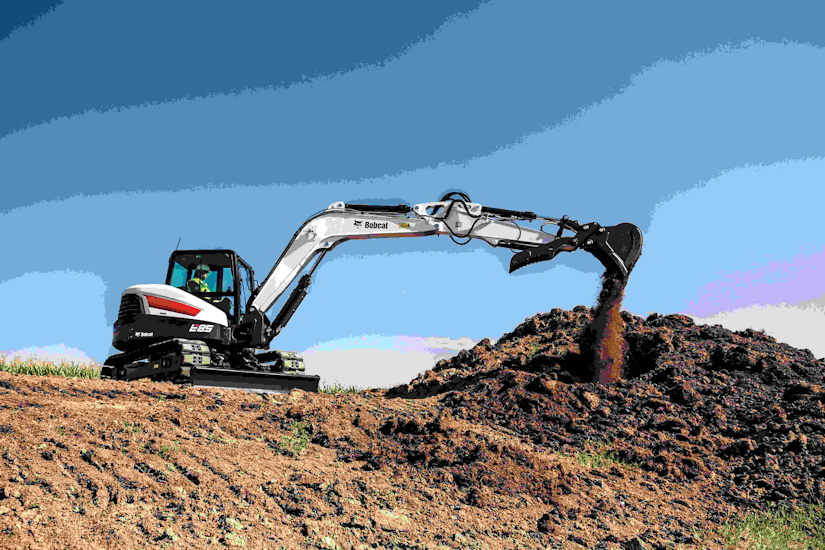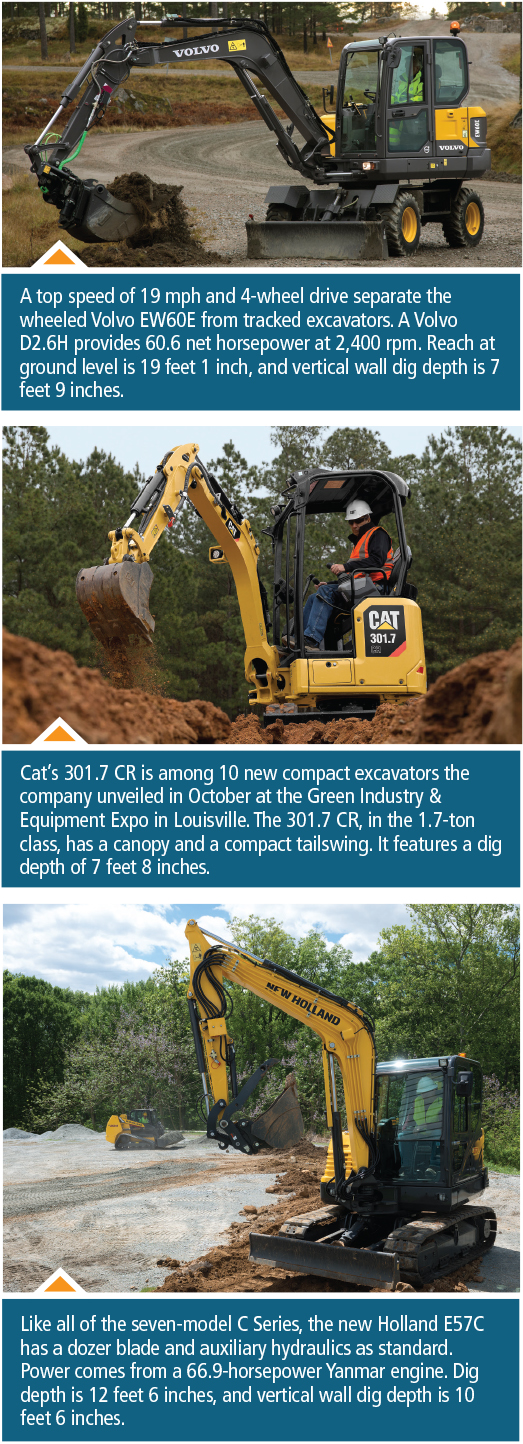By Richard Ries

The 8.6-ton Bobcat E85 now has an integrated rear counterweight and an optional hydraulic pin grabber. A rocker-style thumb switch on the left joystick provides better metering of boom swing control than do foot pedals, the company says.
Though still used for just excavating, compact excavators are being deployed on a variety of tasks, as owners seek greater value from these versatile machines.
And some compact excavator owners are getting inventive.
“I never thought you could put a shear on a 2-ton machine,” says John Comrie, Volvo Construction Equipment product manager. “But that’s exactly what one of our customers did on a recent demolition job.”
OEMs are getting inventive, too.
Volvo offers a Steelwrist tiltrotator, with plus-and-minus 45 degrees of tilt and 360 degrees of rotation, on excavators of 3.5 tons and over.
 Comrie says many Volvo customers find “they can do a lot more with a combination of a skid steer or mini track loader paired with a mini excavator, than with one mid-sized backhoe.”
Comrie says many Volvo customers find “they can do a lot more with a combination of a skid steer or mini track loader paired with a mini excavator, than with one mid-sized backhoe.”
The ability to rotate 360 degrees gives compact excavators greater versatility than backhoe loaders while offering comparable digging and lifting performance and the ability to use a full range of tools and attachments, he says. Backhoes have enjoyed the advantage of higher travel speed, but Comrie points out the Volvo EW60E wheeled compact excavator can now reach 19 mph.
“In the smaller size class, it’s rare to see just a machine and a bucket,” says Todd Dohnal, dealer development manager for Kobelco USA. “Typically, the unit will have an array of attachments.”
“Excavators do not just dig holes these days,” he adds. “They have become one of the most versatile pieces of equipment on the jobsite.”
A plethora of attachments
Dohnal says the challenge for manufacturers will be to keep up with hydraulic requirements of this expanding catalog of tools and attachments.
It appears, though, that OEMs are up to the task.
For example, most Kubota models allow programming of up to five hydraulic flow rates for specific attachments. The operator can select a rate by pushing a button. Load-sensing hydraulics and hydraulic regeneration circuitry further improve speed, power and precision.
“Over 95 percent of compact excavators are purchased with thumbs, breakers, mowers, augers, tilt buckets or trench compactors,” says Jeff Jacobsmeyer, Kubota product manager.
The Link-Belt 80 X3 SA is available with several auxiliary hydraulic options including single-acting with pedal or proportional joystick control, multifunction with proportional joystick or combination hydraulics with proportional joysticks. The latter option provides multifunction and rotate auxiliary hydraulics and can be configured to adjust pressure settings from inside the cab.
 Hydraulic quick-connects are options on most models and standard equipment on some. Up to four hydraulic circuits are available.
Hydraulic quick-connects are options on most models and standard equipment on some. Up to four hydraulic circuits are available.
Tom Connor, product specialist at Bobcat, says they now offer a thumb, also known as a clamp, on their 2-ton E20 to meet demand. Thumbs have been available on larger models for some time.
Conner says Bobcat is also seeing demand for flail mowers for compact excavators. Bobcat offers two mowers: a 30-inch model for excavators of 3 to 4 tons and a 40-inch model for the 4- through 8.5-ton classes. The same ballast counterweights offered with the long-arm option on their compact excavators are available for use with flail mowers.
Justin Lantin, product marketing manager at Komatsu, says operators are also getting more use out of blades. They’re still vital for stabilizing while digging and for backfilling, but they are also being used for grading and cleanup, bringing more efficiency to the jobsite.
Komatsu partners with attachments manufacturer Werk Brau. This streamlines the spec’ing process for customers and reduces freight costs compared to buying the machine from one source and the tools and attachments from another, he says.
Lantin also notes that some compact excavators possess a special feature that gives them further versatility. They can work indoors.
“There’s always demand for more power and more breakout force in those applications, but our machines are also rigged and ready for essentially any tools and attachments, including those in demand for indoor use,” he says.
Warranty war
Along with becoming more inventive, OEMs are getting more competitive, especially when it comes to warranties for compact excavators.
One of the first things you’ll notice about the current crop of compact excavators is that there is no “standard” standard warranty. They come in a variety of combinations: one year, two years, three years; 1,800 hours, 2,000 hours, 3,000 hours, 10,000 hours, unlimited hours.
 Extended warranties are also available, and several manufacturers offer custom warranties covering specific systems or components for a certain number of months or hours, as requested by the customer. Some OEMs offer the same warranty they have for years, while others changed their warranties just this year. Still others say they’re considering making changes soon.
Extended warranties are also available, and several manufacturers offer custom warranties covering specific systems or components for a certain number of months or hours, as requested by the customer. Some OEMs offer the same warranty they have for years, while others changed their warranties just this year. Still others say they’re considering making changes soon.
It’s crucial that customers negotiate the best warranty value for their needs. You don’t know until you ask what’s on the table. You should also closely inspect warranty terms on the sales agreement. Make sure it says you’re getting what you think you’re getting. The warranty that’s enforceable is not based on conversations you had with the dealer’s representative but on what’s written in the sales agreement.
So why all the different warranty offers?
Manufacturers that have recently increased coverage say this better reflects the reliability and durability of current models.
“Compact excavators typically stay healthier longer than other types of compact equipment,” says Chris Ballentine with New Holland. “While compact track loaders and skid-steer loaders see use that borders on abuse, compact excavators are used more conservatively.”
Modern designs and materials have further enhanced their durability.
But another reason for all the action stems from a warranty war in compact equipment. In a crowded, noisy marketplace full of seemingly similar machines, OEMs are struggling to differentiate their offerings. Tweaking warranties is one way to do that.
Telematics are often part of the warranty package. System costs have dropped and the technology is scalable, so lower-cost telematics can be included in the price of lower-cost equipment.
Link-Belt offers RemoteCARE GPS-enabled telematics subscriptions free for the life of their machines. RemoteCARE has all the aspects of a basic telematics package, including PM tracking, machine health reports and machine location.
Takeuchi added two years of Takeuchi Fleet Management telematics to their warranty package in August 2016. Coverage is free for all current excavators.
The goal is to “increase uptime by better scheduling service and improve utilization by understanding how the machine is being used in the field,” says Lee Padgett, product manager at Takeuchi. “TFM also helps protect assets from misuse and theft through the use of geofencing.”
Strong demand in good times and bad
Worldwide demand for compact equipment of all types is growing, and compact excavators are no exception.
 “China is a very hot market for excavators,” says Dohnal. “Many manufacturers, including Kobelco, produce units specifically for the Chinese market since it’s among the big markets outside the emissions regulations that have dramatically influenced North America, Europe and Oceana.”
“China is a very hot market for excavators,” says Dohnal. “Many manufacturers, including Kobelco, produce units specifically for the Chinese market since it’s among the big markets outside the emissions regulations that have dramatically influenced North America, Europe and Oceana.”
How does that affect the U.S. market?
“This puts a heavy demand on components,” says Dohnal. “It’s a challenge for manufacturers to keep pace with demand, to manage the cycle. Lead times have increased.”
Connor, with Bobcat, says the biggest influence on compact excavators is the housing market. That’s good news because it adds stability.
“With housing, as it relates to compact excavators, there is no bad time,” he says. “When the market is strong, new construction creates demand. When the market is soft, remodeling and landscaping drive sales.” He says commercial construction such as strip malls also puts a lot of compact excavators to work.
And with a recent tumultuous ride in the stock market, customers are a bit uneasy, which could also make compact excavators more popular.
“An uncertain economic climate means businesses need to do more with less,” says Ballentine, with New Holland. “Their equipment needs to do the same.”
The rental market also continues to gobble up a large percentage of the compact excavators produced, as it always has. The traits that make compact excavators ideal for rental are also finding favor with owner-operators: low initial and ongoing costs and ease of transport, says Jonny Spendlove, product marketing manager for Hitachi and John Deere.
Spendlove says that in the United States there’s a trend away from rental toward owning. He’s also seeing a move toward the larger end of the compact spectrum. Some of this is the result of jobsite demands and some the result of a desire to run larger or more resource-hungry attachments. But for the most part, it’s just a desire to move more dirt more efficiently.
He notes that despite their versatility, compact excavators’ usage rates are lower than other compact machinery. They’re often on trailers between jobs or working in lower-hour applications such as landscaping.
But Spendlove says it’s important that customers take advantage of the attachment offerings for compact excavators.
“While compact excavators might not always have the same utilization rates as larger equipment,” he says, “their versatility and ability to use a wide range of attachments make them valuable on a jobsite.”
